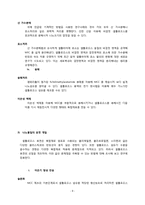[고분자공학] Development of Biodegradable High-performance Nanocomposite
 등록일 / 수정일
등록일 / 수정일 페이지 / 형식
페이지 / 형식 자료평가
자료평가 구매가격
구매가격
- 2010.01.27 / 2019.12.24
- 19페이지 /
 docx (MS워드 2007이상)
docx (MS워드 2007이상) - 평가한 분이 없습니다. (구매금액의 3%지급)
- 1,700원
최대 20페이지까지 미리보기 서비스를 제공합니다.
자료평가하면 구매금액의 3%지급!
 1
1 2
2 3
3 4
4 5
5 6
6 7
7 8
8 9
9 10
10 11
11 12
12 13
13 14
14 15
15 16
16 17
17 18
18 19
19
추천 연관자료
- 목차
-
1. Summary
2. Motivation
1) 높아지는 바이오폴리머에 대한 관심
2) Poly(lactic acid)의 특징
3) PLA nanocomposite
3. Objective
1) 균일한 Cellulose nanowhisker 다량 형성
2) 표면특성 연구 및 표면 개질법 개발
3) 응집을 방지하기 위한 연구
4) 결정화 특성 연구:
5) 대량 생산으로 실제 제품에 적용 가능한 공정 개발
4. Project details
1) 셀룰로오스의 특성과 셀룰로오스 나노위스커 공급원
i. 초미세 셀룰로오스 물질의 원료
2) 셀룰로오스 나노물질을 얻는 방법.
i. 목재의 화학적 분쇄
ii. 기계적 분쇄
iii. 화학적 분쇄
iv. 용해
3) 나노물질의 표면 개질
i. 이온기 형성 반응
ii. 유도체화 반응
iii. 흡착을 위한 표면개질
5. Patent/paper Search
1) Patent
2) Paper
6. Future work
1) Strength
2) Weakness
3) Opportunity
4) Threats
7. Buget
9. Conclusion
10. References
- 본문내용
-
2. Motivation
1) 높아지는 바이오폴리머에 대한 관심
바이오폴리머란 재생가능한 유기자원으로부터 만들어지는 고분자 물질을 말하는데, 대개의 경우 생분해성을 갖기 때문에 ‘bio-based’이자 ‘biodegradable’하다고 정리할 수 있다. 이들은 자연계의 자원으로부터 만들어지고, 사용 후엔 자연계 내의 미생물에 의해서 물과 이산화탄소로 분해되므로 생산에서 폐기까지 모두 환경에 대한 부하가 적은 친환경적인 제품이다. 전 세계적으로 환경보호와 고유가의 대안에 관심이 증대되고 있는 요즘 상황에서, 환경친화적이며 재생가능한 자원으로부터 고분자를 생산하고 환경오염없이 안전하게 폐기할 수 있다는 점에서 바이오폴리머는 매우 획기적인 아이템이다.
이러한 큰 매력을 가졌기에 수십 년간 많은 연구개발이 있었지만 세계 플라스틱 시장에서 바이오폴리머가 차지하는 비중은 1% 미만에 머물고 있다. 물리적인 물성 등의 이유도 있지만 바이오폴리머 시장이 성장하지 못한 가장 큰 이유는 가격 경쟁력이다. 그러나 6~7년 전 까지도 석유화학 제품에 비해 열배에서 수십 배나 비쌌던 바이오폴리머의 가격은 생물공학 기술의 진보 등에 힘입어 불과 몇 배에서 최저 1.2배 정도까지 좁혀졌으며, 유가가 상승할수록 가격 경쟁력은 더욱 커지게 된다.
이렇게 최근 몇 년 사이 바이오폴리머가 가격 경쟁력을 갖출 수 있게 된 것에는 국제적인 메이저 화학기업들의 대규모 공장 설립이 큰 영향을 주었다. 현재 대표적인 바이오폴리머 수지 메이커로는 미국의 NatureWorks, DuPont, Metabolix, 독일의 BASF, 이탈리아의 Novamont 등이 있다. 특히 Cargill과 Dow의 합작사인 NatureWorks는 Poly(lactic acid)(이하 PLA) 시장을 주도하고 있다. PLA는 옥수수에서 추출한 젖산(lactic acid)을 원료로 생산되며 물질이 미생물에 분해되는 생분해성도 함께 가지고 있다. 현재 NatureWorks의 PLA수지 생산량은 연산 15만t이다.
- 참고문헌
-
1. NatureWorks, Technology Fucus Report: Toughened PLA, 2007
2. NatureWorks, Technology Fucus Report: Blends of PLA with Other Thermoplastics, 2007
3. NatureWorks, PLA Engineering Properties
4. EBN ÈÇÐÁ¤º¸ 215È£
5. 정영규, et al., 친환경소재로서의 Poly(lactic acid), 섬유기술과 산업, 2008
6. M. Grunert, W. T. Winter, Nanocomposites of Cellulose Acetate Butyrate Reinforced with Cellulose Nanocrystals, Journal of Polymers and Environment, 2002
7. J. Juntaro, et al., Nanocellulose enhanced interfaces in truly green unidirectional fibre reinforced composites, Composite Interfaces, 2007
8. V. Favier, et al., Polymer Nanocomposites Reinforced by Cellulose Whiskers, Macromolecules, 1995
9. A. K. Mohanty, et al., Biofibers, Biodegradable polymers and biocomposites: An overview, Macromolucular Materials Engineering, 2000
10. J. Y. Nam, S. S. Ray, M. Okamoto, Crystallization Behavior and Morphology of Biodegradable Polylactide/ Layered Silicate Nanocomposite, Macromolecules, 2003
11. S. S. Ray, M. Okamoto, Biodegradable Polylactide and Its Nanocomposites: Opening a New Dimension for Plastics and Composites, Macromol. Rapid Comm., 2003
12. Azizi Samir , Alloin F, Dufresne A., Review of recent research into cellulosic whiskers, their properties and their application in nanocomposite Field, Biomacromolecules, 2005
13. 강태근, 셀룰로오스 나노복합재료, KOSEN Expert review, 2009
14. 성기태, 폴리젖산섬유, KISTI 기술뉴스브리프
15. P. H. T. Vollenberg, D. Hinkens, Particle size dependence of the Young’s modulus of filled polymer; 1. Preliminary experiments, Polymer, 1989
16. M. S. Huda, et al., Chopped glass and recycled newspaper as reinforcement fibers in injection molded poly(lactic acid) (PLA) composites: A comparative study, Composites Science and Technology, 2006
17. G. Siqueira, J. Bras, A. Dufresne, Cellulose whiskers versus microfibrils: Influence of the nature of the nanoparticle and its surface functionalization on the thermal and mechanical properties of nanocomposites, Biomacromolecules, 2009
자료평가
-
아직 평가한 내용이 없습니다.










